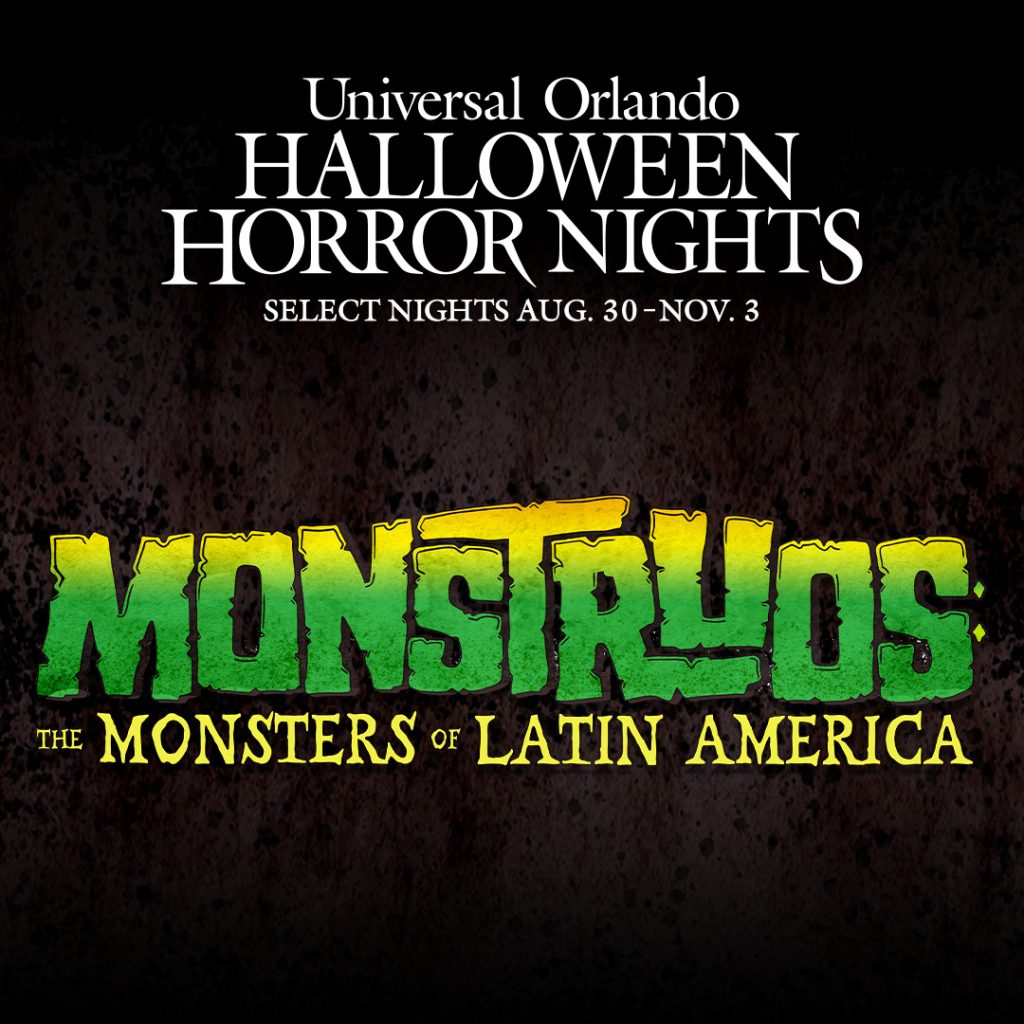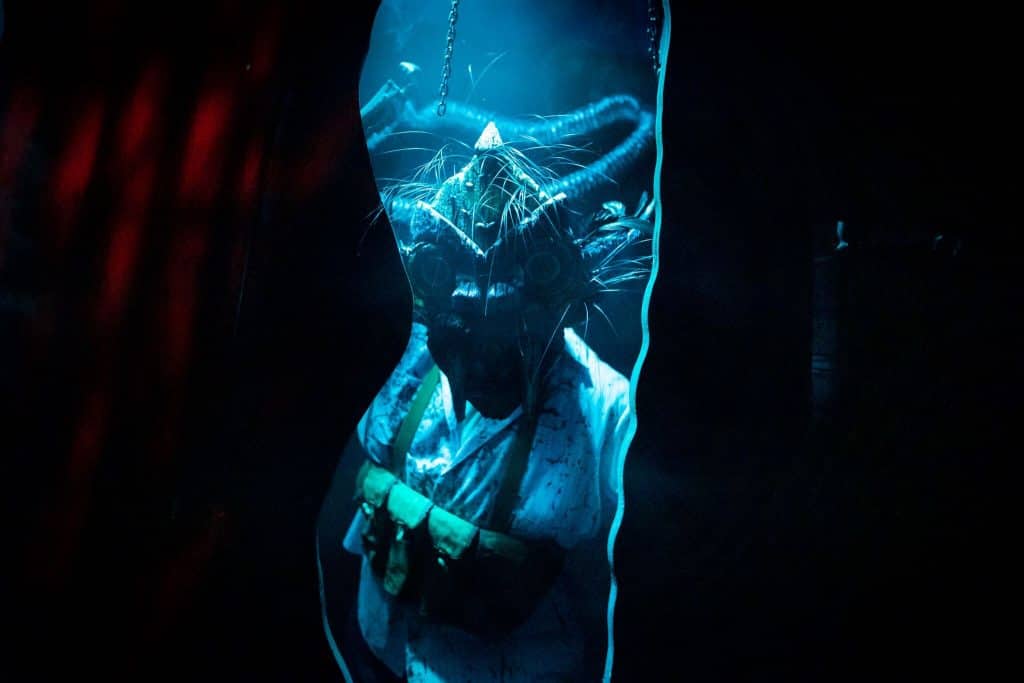Halloween Horror Nights, now in its 33rd year, has solidified its reputation for horror not only through its collaborations with media properties such as The Walking Dead and Stranger Things but also for chilling, original concepts created for their guests. Most recently, Universal Orlando revealed six original houses for 2024, with one particularly exciting addition – Monstruos: The Monsters of Latin America.
Inspired by Latin American folklore, this house brings visitors face-to-face with three monsters of legend: Tlahuelpuchi, La Lechuza, and El Silbón, with El Muerte, the spirit of Death, acting as their guide.

While this maze is brand new to Orlando, it first appeared in Universal Studios Hollywood, where it became a hit among our West Coast friends, even opening the way for a sequel house just announced for Hollywood’s 2024 season – Monstruos 2: The Nightmares of Latin America. As we wait in anticipation for Florida’s iteration, we can use what we know from both of Hollywood’s Monstruos houses and Universal Orlando Resort’s official announcement, as well as the traditional stories Monstruos is inspired by, to get a taste of what to expect at Halloween Horror Nights 33.
Before we get too far, we should remind you that Halloween Horror Nights 33 runs on select nights from August 30 through November 3. If you’re like us and anxiously counting the days, you can purchase discounted single-night HHN tickets through us!
Now, gather your Scream Squad as we step into the dark world of Monstruos: The Monsters of Latin America.
Who are the creatures in Monstruos: The Monsters of Latin America?
La Muerte
While La Muerte isn’t specific to Latin America or even technically a monster, we should first touch on how they became our journey’s guide. While she’s known by many names, La Muerte (or simply translated: “Death”) is better known as Santa Muerte, or the Saint of the Dead, throughout Mexico.
In many cultures, there are some variations of the personification of Death, and we can expect Universal Orlando Resort’s creatives to put their unique spin on her. Generally, La Muerte is perceived as a woman, though she bears a familiar look as a hooded skeleton and holds a scythe.
Aside from her scythe, she’s also commonly seen holding a globe, but she isn’t restricted to just these two items. She also possesses an hourglass and an owl. Each of La Muerte’s items has a symbolic meaning, with the scythe representing her reach with its lengthy handle, the blade representing life’s beginning and end, and it overall serving hope and prosperity since it’s a common farm tool. Other items like the globe and hourglass have similar meanings to not only the scythe but also each other as they represent La Muerte’s presence across the world, her omnipotence, and that death isn’t necessarily the end since the hourglass can be inverted.
La Muerte, as our guide in Monstruos, is fitting as she’s known within a multitude of cultures for so much more than being a collector of souls. La Muerte’s appearance can seem horrific, but she’s actually a very benevolent spirit and is known as a powerful protector. As the visitors of Halloween Horror Nights encounter the monstrous legends of Latin America, one can’t help but wonder about the price of safety under the watch of such a powerful entity.
Tlahuelpuchi
Tlahuelpuchi is a vampiric witch that originates in Mexico and is thought to have origins dating back to the Aztecs. What’s especially scary about them is that a tlahuelpuchi could be anyone. Though they’re commonly women, they’re the product of an unpredictable curse that doesn’t show itself until around puberty. Once it’s in effect, the tlahuelpuchi must feed on blood once a month, or else they die.
When hunting and in the public eye, Tlahuelpuchi will shapeshift to blend in, taking on the form of a turkey vulture or another species of bird. Although much of their behaviors and abilities have a vampiric lean, they’re also mystic practitioners, performing rituals to change their form and claim victims. For example, before shapeshifting, the tlahuelpuchi must set a roaring fire in the middle of the floor of their home using specific woods and spices. They must then walk back and forth through the flames and detach their legs before becoming their chosen animal. Once they’ve chosen their victim, they must fly over their prey’s house in a cross formation before they can enter.
It should be noted that tlahuelpuchi take no pride in what they have to do, and because of this, they exist almost entirely in hiding once their curse reveals itself. Adding to these tragic circumstances, their family is obligated to protect them by any means necessary, lest the member who doesn’t abide by the curse will become one themselves. This rule has led to family members going so far as to help hide the tlahuelpuchi or even assist in their hunt for blood.
La Lechuza
By definition, La Lechuza’s name may not translate to anything scary as it’s the Spanish word for “owl,” but don’t let that drop your guard! Much like La Muerte, this monster is known by a few names in the regions of Mexico from which she hails, and many versions vary on how she became “the Owl Witch.” The majority of legends tell of a woman who was wronged in some way by either a man or her village, which led her to make a deal with the Devil to reap her vengeance.
Shifting our gaze to La Lechuza’s appearance, she’s widely accepted to appear as a gigantic barn owl with a fifteen-foot wingspan and the face of a woman of varying age as she also can shapeshift. Often, she’ll become a humanoid owl with talon-like fingers that emphasize her witchy appearance.
La Lechuza’s owl-like appearance is also more than a cryptid fashion choice. Within Latin legends, owls were messengers of Death and a bad omen, and La Lechuza is no different in this regard. To dream of her is said to be a prediction of the death of a family member or loved one.
Aside from this, the Owl Witch has quite a few supernatural powers at her disposal as well. She can manipulate the weather, is generally considered to be immortal, and is immune to most weapons. Additionally, if someone attempts to kill La Lechuza or touch one of its feathers, they’ll die.
In terms of her victims, La Lechuza will draw them out by mimicking the cries of a baby or whistling with her supernaturally alluring voice. Those who hear it are beckoned to investigate the noise, and by the time they come to their senses, it’s already too late.
El Silbón
El Silbón (or “The Whistler) is one of this author’s favorite monsters. His origin story has quite a few interpretations, but the more popular one in Venezuelan and Colombian culture tells a tragic tale along the lines of Romeo and Juliet. A teenage boy falls in love with a girl his father disapproves of. Despite his father’s requests that they cease seeing each other, the couple continue their courting until one day, the boy’s father catches them in his barn. The father, in a fit of rage, murders the girl in front of his son. Equally enraged with vengeance, the son retaliates by taking his father’s life.
To cover up what just transpired, the boy dismembers his father’s corpse, removing the meat from the bones, which he hides in a sack. He takes the meat to his mother, who uses it for their dinner, not knowing where it actually came from. Upon serving it to her family, the mother realizes the heartbreaking truth. After some time, the boy’s paternal grandfather arrives home and punishes the boy upon learning of his misdeeds. The grandfather ties the boy to a post, violently whipping his back and pouring lime juice, salt, and alcohol into his bloody wounds. After the boy is finally released, his grandfather condemns him to carry the sack filled with his father’s bones for all eternity. As the boy shoulders the grim burden and takes his first cursed steps, the grandfather sets the family’s hunting dogs on him, driving the boy into the nearby woods.
It isn’t clear exactly how or when the boy’s appearance changed, but what’s known is that it was drastic — he became a tall, gangly, ghoulish creature said to average between nine ant twelve feet tall. He also still bears the now-tattered farming clothes and hat he wore when he was punished.
Although El Silbón doesn’t need to feed upon his victims, that doesn’t mean he won’t exact his insatiable vengeance on an unsuspecting mortal. It’s been said that you can hear the bones in his sack clattering as he travels, and if you hear his namesake, an upward whistle — be wary! If the whistle sounds near, he’s actually some distance away. However, if the whistle sounds as if it’s from a distance, that poor soul’s fate is already doomed to be a part of El Silbón’s bone collection.
The Monsters of Latin America: A Haunting Presence at HHN

For anyone unfamiliar, this isn’t the first time the creatives behind Halloween Horror Nights have explored the monsters of Latin America. Over the years, we’ve made several trips to Latin America during the event. In 2022, Universal Studios Florida’s Halloween Horror Nights featured Fiesta de Chupacabras, a house steeped in the legend of the Chupacabra. Here, a seemingly innocent celebration in a Latin American village concealed a gruesome truth, as the festivities were tainted with the blood of tourists.

In 2013, HHN Orlando dipped its toes into Latin American folklore with Urban Legends: La Llorona after the concept had seen several years of success in Hollywood. Based on the legends of the Weeping Woman, this house brought guests to an old Mexican church and what’s presumed to be the funeral of one of La Llorona’s victims. Almost immediately upon entering and frequently throughout the house, they’re attacked and shown victims of the Weeping Woman. As they navigate through the house, the cries and weeps of La Llorona can be heard, often alongside the literal streams of those who have suffered at her hands. In this author’s opinion, it wasn’t a house for the faint of heart due to its nature, but it was very well executed. La Llorona was even so well received that the character also appeared in the ICONS: HHN house during HHN 25.
When Monstruos makes its appearance at Universal Studios Florida, a familiar take should be expected. This would include the monsters’ appearances, the set design, and some of the storytelling. With that said, some liberties could be taken to help differentiate Orlando from Hollywood. This could be the case with either the lore or the house. For instance, Fiesta de Chupacabras was only loosely based on the monster’s mythology, and Urban Legends: La Llorona at Universal Orlando Resort utilized roughly half of the original set from Hollywood.
In any case, Monstruos: The Monsters of Latin America is sure to be a house worthy of the entire Scream Squad at Halloween Horror Nights 33.
Learn more about Halloween Horror Nights in our insider’s guide, then discuss it all with 170,000+ other Universal die-hard fans in our Orlando Informer Community on Facebook. And be sure to follow Orlando Informer on TikTok, Threads, Facebook, Twitter, and Instagram for the latest news, tips, and more at Universal Orlando, Walt Disney World, and other Orlando attractions.
